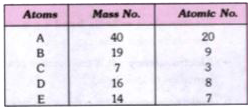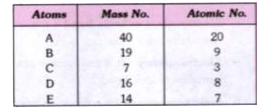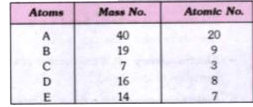Complete Solutions to Additional Questions for Practice of chapter CHEMICAL BONDING of Class 10 book with complete answers and questions
| Class 10 | CHEMISTRY |
| Chapter | CHEMICAL BONDING |
| EVERGREEN PUBLICATION | Additional Questions for Practice |
| Number Of Questions | 32 |
| Academic Year | 2023-24 |
An atom X has 2, 8,7 electrons in its shells. It combines with Y having 1 electron in its outermost shell.
What type of bond will be formed between X and Y ?
View SolutionAn atom X has 2,8,7 electrons in its shells. It combines with Y having 1 electron in its outermost shell.
Write the formula of the compound formed.
View SolutionAn atom X has 2, 8,7 electrons in its shells. It combines with Y having 1 electron in its outermost shell.
Would it be soluble in water?
View SolutionThe electronic configuration of chloride ion is the same as that of an argon atom. What is the difference between the two ?
View SolutionIn the formation of the compound `XY_(2)`, an atom X gives one electron to each Y atom. What is the nature of bonds in `XY_(2)` ? Give two properties of `XY_(2)`.
View SolutionAn atom has two electrons more than the noble gas configuration. What type of ion will it form?
View SolutionWhat are the conditions necessary for the formation of covalent molecules ? Give their properties.
View SolutionElements A, B and C have atomic numbers 9, 20 and 10 respectively.
State which one is :
(i) a non-metal
(ii) a metal
(iii) chemically inert.
View SolutionElements A, B and C have atomic numbers 9, 20 and 10 respectively.
Write down the formula of the compound formed by two of the above elements.
View SolutionState three differences between 'X' and '`X^(+)`' i.e., an atom and an ion.
View SolutionDifferentiate between polar and non-polar covalent molecules.
View SolutionExplain with the help of (i) an ionic equation (ii) electron dot structural diagram (iii) atomic or orbital structural diagram for the formation of the following:
(a) Sodium chloride (b) Calcium oxide (c) Magnesium chloride.
View SolutionDraw the structure of ammonia molecule.
View SolutionExplain the following:
Ionic compounds conduct electricity.
View SolutionExplain the following:
lonic compounds have high melting point and boiling point while covalent compounds have low melting and boiling points.
View SolutionExplain the following:
Ionic compounds dissolve in water whereas covalent do not.
View SolutionExplain the following:
lonic compounds are usually hard crystals.
View SolutionPredict the type of bonding in the following molecules:
Oxygen
View SolutionPredict the type of bonding in the following molecules:
calcium oxide
View SolutionPredict the type of bonding in the following molecules:
water
View SolutionPredict the type of bonding in the following molecules:
methane
View SolutionPredict the type of bonding in the following molecules:
ammonium ion
View SolutionFive atoms are labelled from A to E

Which one of these atoms :
(i) contains 7 protons ?
(ii) has an electronic configuration 2, 7 ?
View SolutionFive atoms are labelled from A to E

Write down the formula of the compound formed between C and D.
View SolutionFive atoms are labelled from A to E

Predict which are :
(i) metals ?
(ii) non-metals?
View SolutionMatch the atomic number 4, 14, 8, 15 and 19 with each of the following:
A solid non-metal of valency 3.
View SolutionMatch the atomic number 4, 14, 8, 15 and 19 with of the following:
A gas of valency 2.
View SolutionMatch the atomic number 4, 14, 8, 15 and 19 with of the following:
A metal of valency 1.
View SolutionMatch the atomic number 4, 14, 8, 15 and 19 with of the following:
A non-metal of valency 4.
View SolutionElements X, Y and Z have atomic numbers 6, 9 and 12 respectively. Which one :
forms an anion
View SolutionElements X, Y and Z have atomic numbers 6, 9 and 12 respectively. Which one :
forms a cation
View SolutionElements X, Y and Z have atomic numbers 6, 9 and 12 respectively. Which one :
has four electrons in the valency shell ?
View Solution
Additional Questions for Practice questions and complete solutions for chapter CHEMICAL BONDING of EVERGREEN CHEMISTRY (ENGLISH) of Class 10
All Exercises from EVERGREEN PUBLICATION Class 10 CHEMISTRY CHEMICAL BONDING
- ADDITIONAL QUESTION
- Additional Questions for Practice
- ILLUSTRATIVE ASSIGNMENTS
- Question
- QUESTION FOR PRACTICE
- QUESTION FOR PRACTICE (Fill in the blanks by selecting a correct word given in the brackets.)
- QUESTION FOR PRACTICE ON EXAMINATION PATTERN
- QUESTIONS
- QUESTIONS (Fill in the blanks from the choices given in the brackets)
- Questions from Previous ICSE Board Papers (2005)
- Questions from Previous ICSE Board Papers (2006)
- Questions from Previous ICSE Board Papers (2007)
- Questions from Previous ICSE Board Papers (2008)
- Questions from Previous ICSE Board Papers (2009)
- Questions from Previous ICSE Board Papers (2010)
- Questions from Previous ICSE Board Papers (2011)
- Questions from Previous ICSE Board Papers (2012)
- Questions from Previous ICSE Board Papers (2013)
- Questions from Previous ICSE Board Papers (2014)
- Questions from Previous ICSE Board Papers (2015)
- Questions from Previous ICSE Board Papers (2016)
- Questions from Previous ICSE Board Papers (2017)
- Questions from Previous ICSE Board Papers (2018)
- UNIT TEST PAPER 2
- WORKSHEET-1
- WORKSHEET-1 (Answer the following questions)
- WORKSHEET-1 (Fill in the blanks with suitable words)
- WORKSHEET-2
- WORKSHEET-2 (Fill in the blanks with appropriate words)
- WORKSHEET-3
- WORKSHEET-3(Give one word for the following)
- WORKSHEET-3(Tick the correct answer)